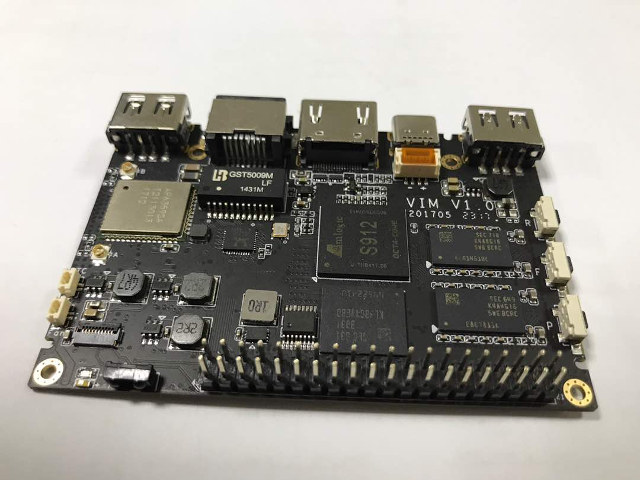We have a decent choice of Amlogic S905 development boards like ODROID-C2 or NanoPi K2, but I was recently asked whether I knew of any Amlogic S912 development boards. I’m sure Amlogic has one for internal development, but those are hard to get, and probably expensive, and while you could probably get an S912 TV box board those lack I/Os, and software support may truly be a challenge. So I’m pleased to announce that Shenzhen Wesion will soon provide an update to their Khadas VIM Pro board with Khadas VIM2 powered by Amlogic S912 octa-core processor.

The company will actually offer three variants of Khadas VIM2 boards (Basic/Pro/Max) specifications with highlights in bold showing differences with Khadas VIM Pro board:
- SoC – Amlogic S912 octa core ARM Cortex-A53 @ up to 1.5 GHz with ARM Mali-820MP GPU
- System Memory
- Basic – 2 GB DDR4
- Pro/Max – 3 GB DDR4
- Storage
- micro SD card and 2MB SPI flash
- eMMC Flash – Basic: 16GB; Pro: 32GB; Max: 64GB
- Video & Audio Output – HDMI 2.0a up to 4K @ 60 Hz with CEC support
- Connectivity
- Basic – Gigabit Ethernet with WoL support, 802.11 b/g/n/ac and Bluetooth 4.1 via Ampak AP6356S module
- Pro/Max – Gigabit Ethernet with WoL support, 802.11 b/g/n/ac with RSDB and Bluetooth 4.2 via Ampak AP6359SA module
- USB – 2x USB 2.0 host ports supporting 900mA and 500mA loads, 1x USB 2.0 type C port supporting power and data only
- Expansion header
- 40-pin 2.54mm pitch header with USB, UART, I2C, ADC, PWM, I2S, SPDIF, and ISO7816
- 10-pin FPC connector with I2C and IOs
- 8 “pin” pogo pads array with USB, I2C, DVB bus, and I/Os
- Misc – Blue LED, white LED, dual channel IR, power/function/reset buttons, header for RTC battery, fan header
- Power Supply – 5V to 9V via USB type C, 4-pin VIN 1.25mm pitch header, or pogo pads for VIN (5V recommended for better efficiency); programmable current limit switch up to 4A (Set to 3A by default)
- Dimensions – 82.0 x 57.5 x 11.5 mm (4x M2 mounting holes)
We can see that it’s not just a processor update with many new features added to the new boards. If like me, you’ve never heard about RSDB, it stands for Real Simultaneous Dual Band, and allows to use both 5 GHz and 2.4 GHz at the same time, while for most dual band modules only one frequency can be used at a given time. That’s a clear advantage if you’re going to use the board as an access point.

The company will provide Android 7.1 Nougat and Ubuntu 16.04 or greater operating systems and SDKs for the board, and work on UEFI support is in progress. The board will be launched last that month, and for now, the only VIM2 specific documentation provided is Amlogic S912 datasheet, but you can be sure there will be a lot more on Khadas Docs page at launch, although I expect many of the instructions available for Khadas VIM (Pro) will still work on VIM2 board.
You’ll find more details on the announcement forum post, such as Linux OpenGL ES not working natively, i.e. without libhybris and Android libraries, and the board has been designed with micro servers in mind with features like WoL and SPI flash for network boot, as well as UEFI support.
Thanks to Geokon for the tip.

Jean-Luc started CNX Software in 2010 as a part-time endeavor, before quitting his job as a software engineering manager, and starting to write daily news, and reviews full time later in 2011.
Support CNX Software! Donate via cryptocurrencies, become a Patron on Patreon, or purchase goods on Amazon or Aliexpress




